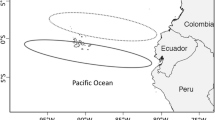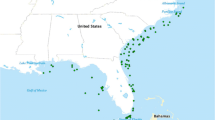Abstract
The shortfin mako, Isurus oxyrinchus, is caught in the eastern North Atlantic as a regular bycatch of the surface-drift longline fishery, mainly directed towards swordfish, Xiphias gladius. Stomachs of 112 shortfin mako sharks, ranging in size from 64 cm to 290 cm fork length, showed teleosts to be the principal component of the diet, occurring in 87% of the stomachs and accounting for over 90% of the contents by weight. Crustaceans and cephalopods were also relatively important in this species’ diet, whereas other elasmobranchs were only present in lower percentages. Meal overlap was observed in half of the sampled sharks. No clear trend of prey size selectivity was found, despite smaller individuals seeming incapable of pursuing larger and faster prey. The retention of small prey was also observed in the diet of all sizes of shark. Seasonality in food habits was in accordance with the current availability of food items. The observed vacuity index of 12% is comparable to foraging ecology studies using gillnetting and appears not to be influenced by baited longline gear. Morphological relationships of the digestive system might add important information to the foraging ecology studies and to ecosystem modelling.
Similar content being viewed by others
References
Anonymous (2005) Report of the 2004 inter-sessional meeting of the ICCAT subcommittee on bycatches: shark stock assessment. SCRS/2004/014. Collective Volume of Scientific Papers 58:799–890
Bass AJ, D’Aubrey D, Kistnasamy N (1975) Sharks of the east coast of southern Africa. IV. The families Odontaspididae, Scapanorhynchidar, Isuridae, Cetorhinidae, Alopiidae, Orectolobidae and Rhiniodontidae. Oceanographic Research Institute, Investigational Report No. 39, Durban, South Africa, 102 pp
Bethea DM, Buckel JA, Carlson JK (2004) Foraging ecology of the early life stages of four sympatric shark species. Mar Ecol Prog Ser 268:245–264
Bone Q, Chubb, AD (1983) The retial system of the locomotor muscles in the thresher shark, J Mar Biol Assoc UK 63:239–241
Capapé C (1975) Observations sur le régime alimentaire de 29 Selaciens pleurotêrmes des côtes tunisiennes. Arch Inst Pasteur Tunis 52:395–414
Carlson JK, Goldman KJ, Lowe CG (2004) Metabolism, energetic demand, and endothermy. In: Carrier JC, Musick JA, Heithaus MR (eds) Biology of sharks and their relatives. CRC Press, Boca Raton, USA, pp 203–224
Casey JG, Kohler NE (1992) Tagging studies on the shortfin mako shark (Isurus oxyrinchus) in the western north Atlantic. Aust J Mar Freshw Res 43:45–60
Cliff G, Dudley SFJ, Davis B (1990) Sharks caught in the protective gill nets of Natal, South Africa. 3. The shortfin mako shark (Isurus oxyrinchus) (Rafinesque). S Afr J Mar Sci 9:115–126
Compagno LJV (1984) FAO species catalogue: sharks of the World: an annoted and illustrated catalogue of shark species known to date. FAO Fish Synop 4:665 pp
Cortés E (1987) Diet, feeding habits, and daily ration of young lemon sharks, Negaprion brevirostris, and the effect of ration size on their growth and conversion efficiency. MS Thesis, University of Miami, Florida, 146 pp
Cortés E (1997) A critical review of methods of studying fish feeding based on analysis of stomach contents: application to elasmobranch fishes. Can J Fish Aquat Sci 54:726–738
Cortés E (1999) Standardized diet compositions and trophic levels of sharks. ICES J Mar Sci 56:707–717
Cortés E, Gruber SH (1990) Diet, feeding habits and estimates of daily ration of young lemon sharks, Negaprion brevirostris (Poey). Copeia 1990:204–218
Fergusson IK, Compagno LJV, Marks MA (2000) Predation by white sharks Carcharodon carcharias (Chondrichthyes: Lamnidae) upon chelonians, with records from the Mediterranean Sea and a first record of the ocean sunfish Mola mola (Osteichthyes: Molidae) as a stomach contents. Environ Biol Fish 58:447–453
Goldman KJ (1997) Regulation of body temperature in the white shark, Carcharodon carcharias. J Compar Physiol Ser B 167:423–429
Gubanov YP (1978) The reproduction of some species of pelagic sharks from the equatorial zone of the Indian Ocean. J Ichthyol 18:781–792
Hyslop EJ (1980) Stomach contents analysis—a review of methods and their application. J Fish Biol 17:411–429
Joyce WN, Campagna SE, Natanson LJ, Kohler NE, Pratt HL Jr, Jensen CF (2002) Analysis of stomach contents of the porbeagle shark (Lamna nasus Bonaterre) in the northwest Atlantic. ICES J Mar Sci 59:1263–1269
Klimley AP (1994) The predatory behaviour of the White Shark. Am Sci 82:122–133
Mejuto J, Scanchez P, de la Serna JM (1992) Nominal catch per unit of effort by length groups and areas of the longline Spanish fleet targeting swordfish (Xiphias gladius) in the Atlantic, years 1988 to 1990, combine. International Commission for the Conservation of Atlantic Tunas SCRS 91/49
Mollet HF, Cliff G, Pratt HL Jr., Stevens JD (2000) Reproductive biology of the female shortfin mako, Isurus oxyrhinchus Rafinesque, 1810, with comments on the embryonic development of lamnoids. Fish Bull 98:299–318
Muus BJ, Nielsen JG (1999) Sea fish Scandinavian Fishing Year Book. Hedehusene, Denmark, 340 pp
Pianka ER (1976) Competition and niche theory. In: May RM (eds) Theoretical ecology: principles and applications. WD Saunders, Philadelphia, PA, pp 114–141
Pikitch EK, Chapman DD, Babcock EA, Shivji MS (2005) Habitat use and demographic population structure of elasmobranchs at a Caribbean atoll (Glover’s Reef, Belize). Mar Ecol Prog Ser 302:187–197
Pope KL, Brown ML, Duffy WG, Michaletz PH (2001) A caloric-based evaluation of diet indices for largemouth bass. Environ Biol Fish 61:329–339
Sbrana M, Sartor P, Belcari P (2003) Analysis of the factors affecting crustacean trawl fishery catch rates in the northern Tyrrhenian Sea (western Mediterranean). Fish Res 65(1–3): 271–284
Schari FS, Juanes F, Rountree RA (2000) Predator size – prey size relationship of marine fish predators: interspecific variation and effects of ontongeny and body size on trophic-niche breath. Mar Ecol Prog Ser 208:229–248
Schoener TW (1970) Nonsynchronous spatial overlap of lizards in patchy habitats. Ecology 51:408–418
Schrey AW, Heist EJ (2003) Microsatellite analysis of population structure in the shortfin mako (Isurus oxyrinchus). Can J Fish Aquat Sci 60:670–675
Sepulveda CA, Kohin S, Chan C, Vetter R, Graham JB (2004) Movement patterns, depth preferences, and stomach temperatures of free-swimming juvenile mako sharks, Isurus oxyrinchus, in the Southern California Bight. Mar Biol 145:191–199
Shimada K (2002) Dental Homologies in Lamniform Sharks (Chondrichthyes: Elasmobranchii). J Morphol 251:38–72
Stevens JD (1984) Biological observations on sharks caught by sport fishermen off New South Wales. Aust J Mar Freshw Res 35:573–590
Stillwell CE, Kohler NE (1982) Food, feeding habits, and estimates of daily ration of the shortfin mako (Isurus oxyrinchus) in the northwest Atlantic. Can J Fish Aquat Sci 39:407–414
Strasburg DW (1958) Distribution, abundance, and habits of pelagic sharks in the central Pacific Ocean. Fish Bull Fish Wildl Serv 138:335–361
Wetherbee BM, Gruber SH, Cortés E (1990) Diet, feeding habits, digestion, and consumption in sharks, with special reference to the lemon shark, Negaprion brevirostris. In: Pratt HL Jr, Gruber SH, Taniuchi T (eds) Elasmobranchs as living resources: advances in the biology, ecology, systematics, and the status of the fisheries. NOAA Technical Report NMFS pp 29–47
Acknowledgments
We sincerely thank the crews of the boats Algamar, Alfamar, Emiliano Pai, Filipa Miguel, Paula Filipa and Rapazinho and the fishing port personnel; special thanks to the staff and scientists from the Instituto de Oceanografia and the Portuguese Association for the Study and Conservation of Elasmobranchs – APECE and Maria José Costa, Joana Marques, Rita Vasconcelos for field and laboratory assistance and commenting on the manuscript; Enric Cortés for elucidation on some diet analysis methods; and one anonymous reviewer for valuable comments. Funding for this project was provided by APECE (http://www.apece.pt) and A. Maia was funded by ESF/Portuguese State under 1/3.2/PRODEP/2003.
Author information
Authors and Affiliations
Corresponding author
Rights and permissions
About this article
Cite this article
Maia, A., Queiroz, N., Correia, J.P. et al. Food habits of the shortfin mako, Isurus oxyrinchus, off the southwest coast of Portugal. Environ Biol Fish 77, 157–167 (2006). https://doi.org/10.1007/s10641-006-9067-7
Received:
Accepted:
Published:
Issue Date:
DOI: https://doi.org/10.1007/s10641-006-9067-7




